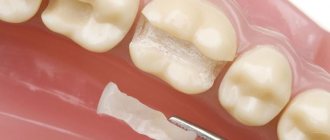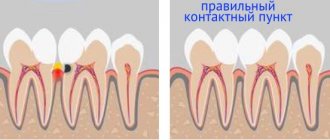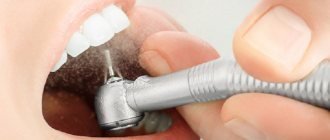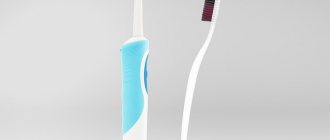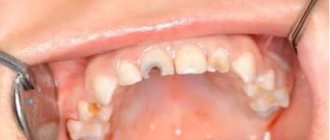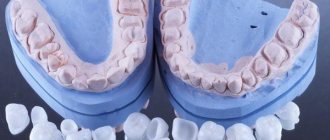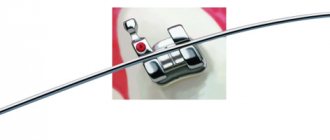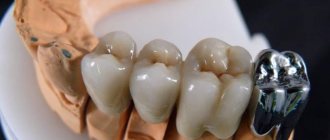Filling baby teeth is the only way to treat caries. Many parents do not want to expose their children to the stress of the sight of a drill and the unpleasant filling procedure, believing that baby teeth will soon fall out on their own anyway. However, each baby tooth must serve until the period of natural physiological change and ensure chewing efficiency.
When asked “should I fill a baby tooth or just remove it?” It's definitely worth choosing a filling. The presence of all teeth in a child's jaw is extremely important for the formation of a correct bite. Moreover, in children, caries rarely affects one tooth; 4 or more teeth are quickly involved in inflammation, and they should not be scattered, since some of them will change only after 9 years.
Failure to treat caries in primary teeth can lead to the following problems:
- infection and destruction of adjacent teeth and antagonist teeth on the opposite jaw,
- infection of the rudiments of permanent teeth located in the area of the roots of baby teeth;
- difficulties in chewing, irritation of the gums between teeth by food debris that accumulates in the carious cavities of the teeth;
- problems with diction if the upper front teeth are affected and severely destroyed;
- poor health and mood of the child, refusal to eat;
- penetration of infection into other organs and systems, decreased immunity.
Removing a diseased baby tooth is justified only in two cases:
- if the caries is in a very advanced state, and an X-ray examination reveals pathological resorption of the root by more than ½ of the length;
- The baby tooth is already mobile and is preparing to “give way” to the permanent tooth.
Types of fillings
The advantage of modern fillings is their durability. They are made from different materials:
- Metal alloys, which were once widely used, are no longer so popular today. They are characterized by high thermal conductivity. But from an aesthetic point of view, such fillings do not look very attractive. Silver amalgam is most often used in dentistry. The advantage of this material is its high wear resistance.
- Many clinics have also stopped using plastic. This material is toxic, another disadvantage is that when installing such fillings, the development of secondary caries is possible. Plastic may darken when exposed to food coloring. The advantage of the material is its strength. Properly placed fillings are quite durable.
- Cement as a filling material has some disadvantages - when using it, it is problematic to achieve the natural color and density of teeth . In addition, healthy tissues have to be sharpened a lot. Cement fillings are phosphate (from phosphate cement) and glass ionomer. The first of these materials is more affordable and easier to use. But it has low mechanical strength . Glass ionomer fillings contain fluoride ions, which help remineralize tooth enamel. But this material cannot be called particularly durable either.
- Composite (photopolymer) materials are used to produce higher quality fillings. They have a high protective function and are aesthetically attractive. Today, the installation of light-cured (light-cured) fillings is widely used. Filling baby teeth with photopolymers is more expensive than other methods, but the financial investment is fully justified.
What fillings are best for baby teeth?
What filling material should I choose? Parents, of course, may have their own preferences, but the doctor still has the final say. This should be a specialist in pediatric dentistry, because there are many specific aspects in the treatment of children.
The dentist will select the filling material, taking into account the age of the child and the condition of the baby teeth that need to be treated.
Composite photopolymers
Dentists have differing opinions regarding this material. Some believe that photopolymer fillings should not be placed on baby teeth because of their toxic effect on the pulp and possible further complications.
Another part of dentists uses photopolymers in their practice, considering them a modern and reliable long-lasting material .
If a child is able to calmly tolerate thorough cleaning of a diseased baby tooth and is not afraid of further manipulations by the dentist, he is recommended to install light-curing fillings.
REFERENCE : Light (photopolymer) fillings harden in the dental cavity when exposed to radiation from a special lamp. They have the property of recreating the natural anatomy of the tooth. Photopolymers with excellent aesthetic effect are often used to fill anterior primary teeth.
If the correct installation technology is followed, light fillings on baby teeth will last until the primary teeth erupt.
During the filling process, the dentist applies the necessary anesthesia - this can be local anesthesia and sedation (induction into a state of half-sleep, while maintaining reflexes).
There are also contraindications to the use of light fillings : acute caries processes and poor dental hygiene. Photopolymers are difficult to attach to weakened tooth enamel.
Glass ionomer cement
What other fillings are placed on children’s baby teeth? Glass ionomer cement, a popular material in pediatric dentistry, consists of powder – crushed glass and liquid – polyacrylic acid.
Advantages of this material:
- has biological compatibility with dental tissues,
- binds well to the structure of the baby tooth,
- connects with other filling materials (high adhesion),
- releases fluoride compounds, which strengthen tooth enamel and are a means of preventing recurrent caries,
- fits tightly to the edges of the tooth.
It also has disadvantages: the material hardens slowly and is sensitive to moisture . At the slightest violation of the dosage, the positive properties of glass ionomer cement are lost.
Colored compomers
Today, children's fillings are even made in different colors. This new product is a compomer, that is, a combination of two materials - glass ionomer cement and a hybrid composite. A compomer filling has the beneficial properties of two components:
- good adhesion,
- biocompatibility,
- resistance to damage,
- release of fluoride into dental tissue to strengthen it,
- wide palette of colors.
IMPORTANT : The use of colored compomers makes filling easier. The child himself chooses the color of the filling, participating in the treatment process. He will be interested in further dental care.
It is worth noting several more advantages of this material: it is plastic - in order to fill a tooth, you do not need to drill it additionally. The chemical composition of the compomer is harmless to the child. The risk of such a filling falling out is minimal due to its strong adhesion . And its bright color will help control abrasion - if you notice changes, you need to visit your dentist.
The child will want to have a multi-colored filling to show off to his peers. This desire facilitates contact with the doctor; the little patient will no longer be afraid of the dentist. This means that future visits to the clinic will take place without any special complications.
Caries of baby teeth
The appearance of caries greatly complicates the life of the baby and his parents.
Baby teeth are prone to rapid destruction and literally in 2-3 weeks an inconspicuous white dot on the enamel turns into a full-fledged carious cavity. If the tooth is not treated, then in the future it will lead to the development of pulpitis, periodontitis, and loss of a baby tooth. Filling has been and remains the most effective method of combating caries. The pediatric dentist will examine the child’s oral cavity, assess the extent of the damage, and select the appropriate filling material. And there is one undeniable advantage of paid treatment. State clinics are limited by VHI requirements for the selection of compositions, but in Aza&Buka pediatric dentistry they use really good and durable material.
When choosing a filling material, the pediatric dentist takes into account several factors:
- the age of the patient and his ability to withstand prolonged treatment;
- neglect of the carious process;
- characteristics of the child’s physical and emotional state.
What is the process of installing a filling?
What is the point of filling? The dentist will remove the damaged natural tissues of the baby tooth and replace them with artificial ones . Filling takes place in several stages:
- It is necessary to numb the area around the tooth that the dentist will fill. To do this, an anesthetic injection is given. And so that the child is not afraid of the injection, this area is first treated with an anesthetic drug.
- Then you need to clean the dental cavity from damaged tissues. This is done using a drill, laser or sandblasting tools.
- After this, the dentist checks the condition of the pulp. There are two options: disinfection, if there is no damage, and removal, if the pulp is inflamed.
- The doctor must make sure that the caries has been removed. The cavity must be cleaned of bacteria. Before applying the filling material, the nerve should be protected with a special gasket.
- The next stage is the filling itself. The material chosen for treatment is applied in layers. They are given hardness by special light. After installing the filling, the tooth needs to be polished and ground.
ATTENTION ! Are you unsure whether to treat a sick baby tooth or just remove it? Choose filling. You need to fight for every child’s tooth! Otherwise, their absence will lead to malocclusion, problems with speech, and improper growth of the main teeth.
How fillings are done in Shifa dentistry
Dental treatment is possible only with the child’s consent, willingness to open his mouth and permission to put a filling. In case of a high level of anxiety, psychological preparation for treatment is indicated; it consists of preparatory teeth cleaning and demonstration of the stages of treatment on a model of artificial teeth. Give the pediatric dentist the opportunity to provide your child with details about the upcoming procedure at the first visit. Having experience communicating with children of different ages, the doctor can predict the child’s reaction.
For young children (up to 3 years old), as well as in the case of a child’s categorical refusal of treatment, sedation may be used, i.e. dental treatment in a dream.
The installation of children's fillings takes place in the following sequence:
- topical anesthesia - treatment of the gums with painkillers to reduce sensitivity at the site of the upcoming injection;
- local anesthesia - injection into the gums in the area of the upcoming treatment;
- cleaning the affected tooth structures using a bur under the control of a caries detector;
- direct filling;
- grinding and polishing the filling surface.
The installation of fillings in our clinic complies with international standards of pediatric dentistry.
Caring for fillings on baby teeth
After a child has fillings placed on his baby teeth , he needs to be careful for a while so as not to damage them. Different filling materials have their own curing period. The dentist should advise parents about the specifics of the type of fillings that were placed on the little patient.
What else does filling care involve:
- In the first days after filling, you should not give children cold or hot food. Such food can damage the bond between dental tissue and filling material,
- It is better to refrain from very hard or sticky products, so as not to accidentally damage the placed fillings,
- After filling, the child’s oral cavity must be monitored especially carefully. If any problems arise: pain, deformation or darkening of the filling, do not delay your visit to the dentist,
- It is important to teach children daily oral hygiene - brushing teeth twice a day, rinsing after meals, using dental floss. Let your dentist recommend the toothpaste and rinses you should use.
- try to limit sour and sweet foods and carbonated drinks in your child’s diet. It is better to dilute juices half and half with water. But there should be more vegetables and protein foods on the menu,
- After installing fillings, you should visit a pediatric dentist at least once every 3 months to check the condition of the filled teeth and identify possible new carious manifestations.
Parents should find out from the dentist what fillings are placed in the clinic and, together with the doctor, choose the option that is suitable for the child. But there should be no doubt that filling baby teeth is necessary to preserve them. You need to take care of your oral health in a timely manner.
